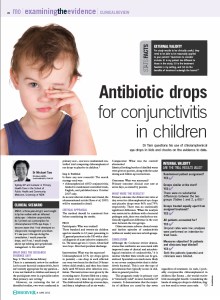 This article was published in Medical Observer.
This article was published in Medical Observer.
The article is also available on the Medical Observer website (may need registration).
Clinical scenario
Emily, a 3-year old girl was brought in by her mother with an inflamed sticky eye – infective conjunctivitis. As I printed out a prescription for chloramphenicol 0.5% eye drops, I became aware that I had developed an idiosyncratic management procedure. If a child had pus in the consultation I would prescribe drops, and if they did not I would simply advise eye toileting and symptomatic management. Is this rational?
Clinical question
How effective are chloramphenicol eye drops in infective conjunctivitis in children?
What does the research evidence say?
Step 1: The Cochrane Library
There is a systematic review for antibiotics for acute bacterial conjunctivitis (up-to-date: October 2007), but it isn’t entirely appropriate for my question – it was not limited to children and many of the participants were in a specialist rather than primary care setting. 1
However, on reviewing the list of identified studies, two were conducted in primary care – one was a randomised controlled trial comparing chloramphenicol eye drops to placebo in children 2 – perfect!
Step 2: PubMed
Is there any new research? I used the search strategy:
chloramphenicol AND conjunctivitis; limited to randomised controlled trials, English, and published since October 2007 only
As no new relevant studies were found, we will look at the aforementioned article (Rose et al. 2005) in detail.
Critical appraisal
We should focus firstly on the method before concerning ourselves with the results.
PICO
Participants: who was studied?
326 children aged 6 months to 12 years presenting to 12 general practices in the UK with a clinical diagnosis of acute infective conjunctivitis. The mean age was 3.3 years. About half were boys. Most had purulent discharge.
Intervention: what was the exposure?
Chloramphenicol 0.5% eye drops (given to parents) – 1 drop in each affected eye every 2 hours for the first 24 hours (when child awake), and then four times daily until 48 h after infection resolution. The instructions were given by the recruiting nurse. Parents filled out a symptom sheet every time drops were given. The child received follow up at 7 days, and then a telephone call at 6 weeks.
Comparator: what was the control/alternative?
Identical looking bottles of distilled water were given to parents, along with the same dosing and follow up instructions.
Outcomes: what was measured?
Primary outcome: clinical cure rate at 7 days, as stated by parents.
Internal validity: are the trial results valid?
Randomised patient assignment?
Yes.
Groups similar at the start?
Yes. There were no substantial differences between the two groups (Table 1 and 2, pg 40). 2
Groups treated equally apart from assigned treatment?
Yes.
All patients accounted for?
Yes. Dropout rates were low; analyses were performed on intention-to-treat basis.
Measures objective? Or patients and clinicians kept blinded?
Yes. Both the patients (parents) and clinicians were blinded.
What were the results?
Primary outcome: the clinical cure rates at day 7 for chloramphenicol eye drops and placebo drops were 86% and 79% respectively. There was no statistically significant difference. When the analysis was restricted to children with a bacterial pathogen only, there was similarly no statistically significant difference in the cure rates between the two groups.
Other outcomes: adverse clinical events and further episodes of conjunctivitis (within 6 weeks) were rare in both groups.
Conclusion
Although the Cochrane review demonstrates that antibiotics are associated with improved rates of clinical and microbiological remission of conjunctivitis, 1 it is unclear whether these results can be generalised. Specialists are much more likely to see severe conjunctivitis that is definitively bacterial. This is not the type of presentation that typically occurs in children in general practice.
This pragmatic study in primary care is “externally valid” in most Australia GP contexts. It demonstrates that the majority of children are cured by day 7 regardless of treatment. As such, I probably over-prescribe chloramphenicol in children like Emma – she would receive little meaningful benefit. Considering the hassle using eye drops in children, they are best used in severe cases only.
Stat facts
External validity
For study results to be clinically useful, they must be relevant to your particular clinical setting. 3 The importance of the results depends on whether they can be reasonably applied to your patient. Questions to consider include: (i) is my patient too different to those in the study, (ii) is the treatment feasible in my setting, and (iii) do the benefits of treatment outweigh the harms? 4
References
- Sheikh A, Hurwitz B. Antibiotics versus placebo for acute bacterial conjunctivitis. Cochrane Database of Systematic Reviews 2006, Issue 2. Art. No.: CD001211
- Rose PW, Harnden A, Brueggemann AB, et al. Chloramphenicol treatment for acute infective conjunctivitis in children in primary care: a randomised double-blind placebo-controlled trial. Lancet 2005; 366(9479): 37-43
- Rothwell PM. External validity of randomised controlled trails: “To whom do the results of this trial apply?” Lancet 2005; 365(9453): 82-93
- RCT Appraisal Sheets. Centre For Evidence Based Medicine [website]. Retrieved on 8 May 2012. http://www.cebm.net/index.aspx?o=1097
